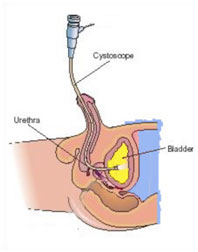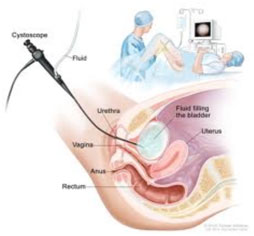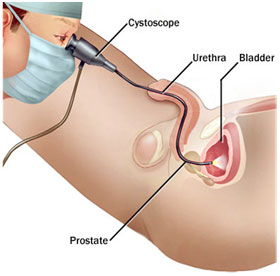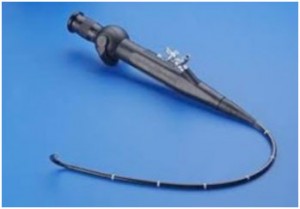Flexible Cystoscopy
WHAT IS A FLEXIBLECYSTOSCOPY
A flexible cystoscopy is a test to examine the uretha (waterpipe) and bladder using a thin, lighted and flexible tube-like telescope called a cystoscope.It is about as thick as a pencil. This instrument is carefully inserted and passed up to the urethra (the tube that passes urine out of the body) and slowly advanced into the bladder.
Cystoscopy allows your doctor to look at areas of your bladder and urethra that usually do not show up well on x-rays.

A cystoscopy gives anatomical information about the lower urinary tract; Areas that can be examined include the following:
- Urethra or urinary channel, which includes the prostate in men
- Bladder, which collects and stores urine
- The 2 ureters, which are small internal tubes that conduct the urine made by each kidney into the bladder.
A doctor can look down the cystoscope, and also pictures can be displayed on a TV monitor. Cystoscopes have side channels where various thin devices can pass down. For example, the doctor may take a small sample (biopsy) from the lining of the bladder by using a thin ‘grabbing’ instrument, which is passed down a side channel.


WHY IT IS DONE
Cystoscopy may be done to:
- Find the cause of symptoms such as blood in the urine (haematuria), painful urination (dysuria), urinary incontinence, urinary frequency or hesitancy, an inability to pass urine (retention) or a sudden overwhelming need to urinate (urgency).
- Find the cause of problems of the urinary tract, such as frequent, repeated urinary tractinfections that do not respond to treatment.
- Look for problems in the urinary tract, such as blockage in the urethra caused by an enlargement of the prostate, kidney stones or tumours
- Evaluate problems that cannot be seen on x-ray or to further investigate problems detected by ultrasound or during intravenous pyelography, such as kidney stones or tumours
- Remove tissue samples for biopsy
- Remove foreign objects
- Place ureteral catheters (stents) to help urine flow from the kidneys to the bladder.
- Treat urinary tract problems
WHY HAVE A FLEXIBLE CYSTOSCOPY
Cystosocpy is useful as a check up for certain bladder and urethral condition and for finding out what is causing symptoms including frequent urinary tract infections (UTI), blood in your urine (haematuria), incontinence, unusual cells found in a urine sample, persistent pain when you pass urine and difficulty passing urine, and for follow up of bladder tumours. It enables the doctor to inspect the bladder lining very closely for abnormal growths.
WHAT ARE THE ALTERNATIVES?
Depending on your symptoms and circumstances, other tests such as an ultrasound (an imaging technique using sound waves) may be suitable for examining your bladder.
It may be essential to have a cystoscopy in order to diagnose some bladder conditions. The cystoscope enables the doctor to view parts of the urethra and bladder that tend not to show up well on x-rays.
WHAT WILL HAPPEN WHEN I HAVE THE FLEXIBLE CYSTOSCOPY?
No special preparation is required. Please, eat and drink normally and take you usual medication (unless you have been advised otherwise)

You will be asked to give a urine sample to check you do not have an infection in your urine a week prior to the procedure, unless recently performed. And could be that your urine is going to be checked the day of the operation. If you have an infection the flexible cystoscopy will not be done on this day. The doctor may give your antibiotics and ask you to come 1-2 weeks later to have the flexible cystoscopy.
If your urine is clear, you will be asked to empty you bladder before the test and to change into a gown.
You will need to lie on your back on a couch for the test to be performed. Flexible cystoscopy is routinely done as an outpatient or day case under local anaesthesia. This means you will stay awake during the procedure. Your doctor will use anaesthetic gel to reduce feeling and lubricate the entrance to your urethra.
The doctor/nurse will clean around the opening of the water pipe (at the end of the penis or entrance to the vagina) with antiseptic, and cover you with sterile drapes.

Local anaesthetic gel is put into the urethra (water pipe) to numb it. Initially the jelly does tingle but soon makes the urethra numb. Once the urethra is numbed, the doctor, an Urologist, will then pass the cystoscope into your urethra to the bladder. You may feel a strange sensation and a little discomfort from this. Men may find it uncomfortable as the camera passes into the bladder. This discomfort should pass once the cystocope is in the bladder.
You will be asked to relax and even to try to pass water as the telescope is passed into the bladder. This is to help the telescope to pass the external sphincter. If the sphincter is not relaxed this is uncomfortable. The urethra and bladder are inspected whilst filling the bladder with water.
Water will be run through the cystoscope into your bladder as this helps give a better view of the bladder. You may feel you want to pass urine as your bladder fills. Ifthis becomes uncomfortable please, let the doctor know and the water can be stopped. If at anytime you feel uncomfortable, please, let us know.
HOW LONG WILL THE TEST TAKE?
About 5 minutes.
You remain awake throughout the procedure. You will be asked to empty your bladder prior to the procedure and a local anaesthetic jelly will be applied to your urethra to help keep you confortable.
WILL THE DOCTOR TELL ME THE RESULTS STRAIGHT AWAY?

Yes. The doctor explains their initial findings and if anything further needs to be done.
The main benefits of the test are that it does not require a general anaesthetic, is quick and the results are available immediately. Flexible cystoscopy is usually performed as a day case. The procedure can be slightly uncomfortable.
You will be asked to sign a consent form before the procedure if you haven’t signed at the outpatient clinic.
CONSENT AND RISKS
A consent form is a legal document, recognizing your willingness to proceed with the intended treatment you are required to sign a consent form for the operation once you fully understand the reason for the operation and the risk involved.
All the operations have risks associated with them. All risks should be discussed with your doctor. You should understand the procedure and any available alternative treatment discussed.
RISKS

Complications are uncommon with this test
Common (greater than 1 in 10)
Bleeding or mild burning when passing urine for a short period after the cystoscopy.
Occasional (between 1 in 10 and 1 in 50)
Urinary infection requiring antibiotic treatment.
Rare (less than 1 in 50)
Temporary insertion of a catheter
Delayed bleeding requiring removal of clots of further surgery
Injury to the urethra causing delayed scar formation
Reaction to the sedative anaesthesia, as skin rash
There is a potential risk of allergic reaction to the lubricant jelly of agents used for cystoscope disinfection, which is estimated to be less than 1:40000
WILL THE DOCTOR TELL ME THE RESULTS STRAIGHT AWAY?
Yes. The doctor explains their initial findings and if anything further needs to be done.
The main benefits of the test are that it does not require a general anaesthetic, is quick and the results are available immediately. Flexible cystoscopy is usually performed as a day case. The procedure can be slightly uncomfortable.
You will be asked to sign a consent form before the procedure if you haven’t signed at the outpatient clinic.
DISCHARGE INFORMATION
- You may see blood in your urine; this is normal and should clear after 1-2 days
- It may burn or sting when you pass urine afterwards, this should get better over the day.
- If you develop a temperature, you urine is smelly/cloudy and burns when you pass urine, you may have a urine infection. You should contact your GP, as you may need a course of antibiotics
- You can eat and drink normally. You should try to drink at least 1.5-2 liters of fluid during the day after you cystoscopy, unless you have been told by a doctor to restrict your fluid intake. Drinking extra water can help to flush out your bladder and reduce the risk of infection. If you continue to drink plenty of fluid, this discomfort and bleeding will resolve rapidly.
- You can drive and return to work after you test should you wish to.
- You may be able to go home straight after the procedure but you may like to have someone with you to take you home.
- You can resume sexual activity as soon as you feel comfortable to de so.
WHAT ELSE SHOULD I LOOK FOR
If you develop a fever, severe pain on passing urine, inability to pass urine or worsening bleeding, you should contact your GP immediately or go to your nearest Emergency Department
IN CASE OF PROBLEMS
Most people have no problems after a cystoscopy, but you should contact your GP if you develop any of the following symptoms
- Persistent, severe pain with an inability to pass urine
- A high temperature
- Burning sensation on passing urine that gets worse or starts again after any initial stinging has worn off
- An unpleasant smell of your urine
- Blood and clots in your urine.
NOTIFY THE UROLOGIST OR ATTEND TO THE EMERGENCY DEPARTMENT
- Prostate: Cancer and Benign Conditions of the Prostate
- Urooncology: Kidney, Bladder, Testicular, Penile Cancer and Retroperitoneal Masses
- Renal Stone Disease
- Urinary Tract Infections
- Andrology and Erectile Dysfunction
- Incontinence, Female Urology and Urodynamics
- Laparoscopic, Open Surgery and Endourology
- One Stage Services
- Paediatric Urology
























